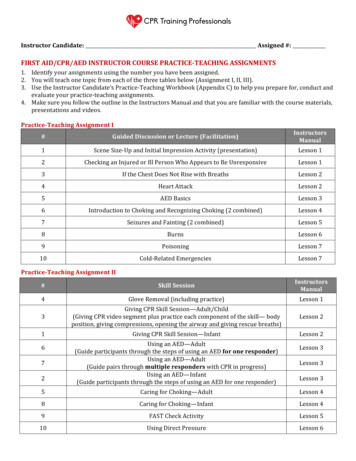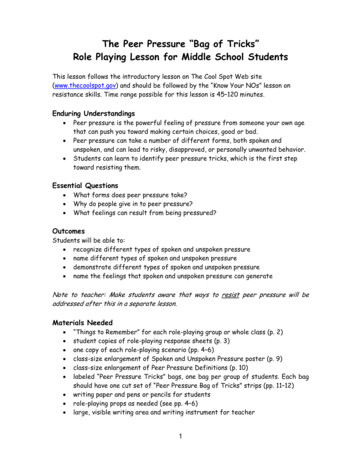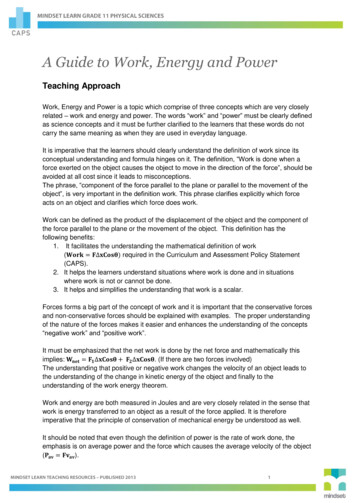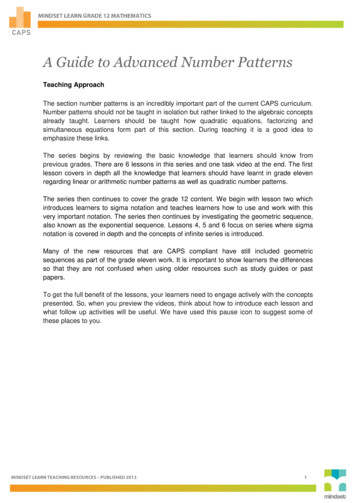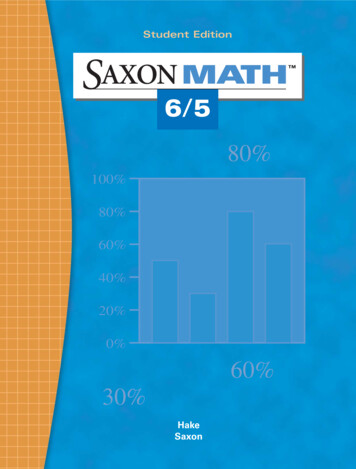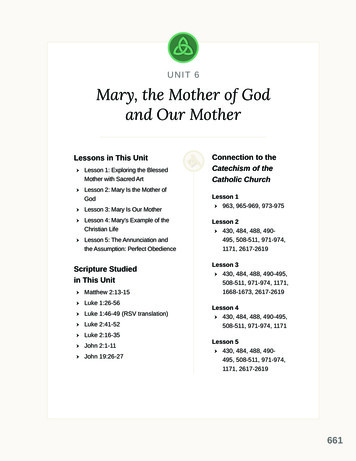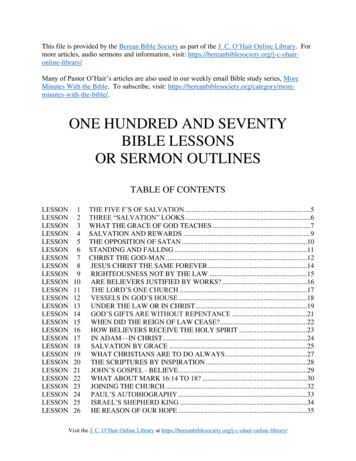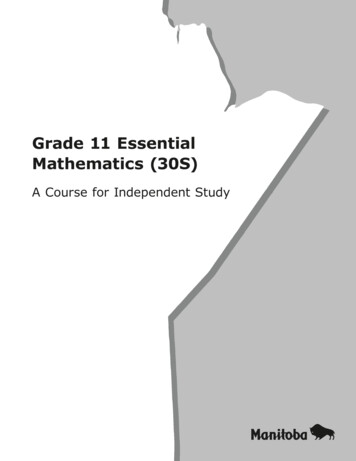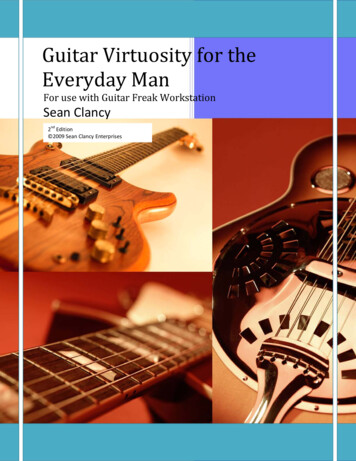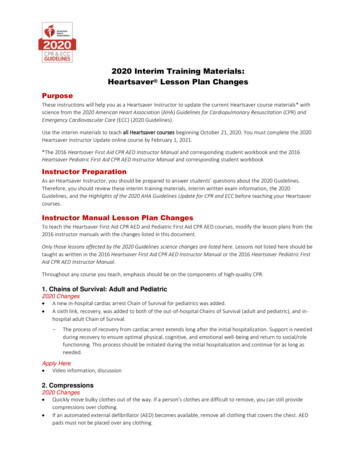
Transcription
2020 Interim Training Materials:Heartsaver Lesson Plan ChangesPurposeThese instructions will help you as a Heartsaver Instructor to update the current Heartsaver course materials* withscience from the 2020 American Heart Association (AHA) Guidelines for Cardiopulmonary Resuscitation (CPR) andEmergency Cardiovascular Care (ECC) (2020 Guidelines).Use the interim materials to teach all Heartsaver courses beginning October 21, 2020. You must complete the 2020Heartsaver Instructor Update online course by February 1, 2021.*The 2016 Heartsaver First Aid CPR AED Instructor Manual and corresponding student workbook and the 2016Heartsaver Pediatric First Aid CPR AED Instructor Manual and corresponding student workbookInstructor PreparationAs an Heartsaver Instructor, you should be prepared to answer students’ questions about the 2020 Guidelines.Therefore, you should review these interim training materials, interim written exam information, the 2020Guidelines, and the Highlights of the 2020 AHA Guidelines Update for CPR and ECC before teaching your Heartsavercourses.Instructor Manual Lesson Plan ChangesTo teach the Heartsaver First Aid CPR AED and Pediatric First Aid CPR AED courses, modify the lesson plans from the2016 instructor manuals with the changes listed in this document.Only those lessons affected by the 2020 Guidelines science changes are listed here. Lessons not listed here should betaught as written in the 2016 Heartsaver First Aid CPR AED Instructor Manual or the 2016 Heartsaver Pediatric FirstAid CPR AED Instructor Manual.Throughout any course you teach, emphasis should be on the components of high-quality CPR.1. Chains of Survival: Adult and Pediatric2020 Changes A new in-hospital cardiac arrest Chain of Survival for pediatrics was added. A sixth link, recovery, was added to both of the out-of-hospital Chains of Survival (adult and pediatric), and inhospital adult Chain of Survival. The process of recovery from cardiac arrest extends long after the initial hospitalization. Support is neededduring recovery to ensure optimal physical, cognitive, and emotional well-being and return to social/rolefunctioning. This process should be initiated during the initial hospitalization and continue for as long asneeded.Apply Here Video information, discussion2. Compressions2020 Changes Quickly move bulky clothes out of the way. If a person’s clothes are difficult to remove, you can still providecompressions over clothing. If an automated external defibrillator (AED) becomes available, remove all clothing that covers the chest. AEDpads must not be placed over any clothing.
Apply Here Heartsaver First Aid CPR AED Instructor Manual Part 5: Heartsaver First Aid CPR AED Lesson PlansAdult CPR AED Lesson PlansooLesson 1: Course Introduction (Discussion)Lesson 2: Adult CPR (Video)Child CPR AED Lesson PlansooLesson 1: Introduction (Discussion)Lesson 2: Child CPR (Video)Infant CPR Lesson Plansoo Lesson 1: Introduction (Discussion)Lesson 2: Infant CPR (Video)Heartsaver Pediatric First Aid CPR AED Instructor Manual Part 5: Heartsaver Pediatric First Aid CPR AED Lesson PlansChild CPR AED Lesson PlansooLesson 1: Introduction (Discussion)Lesson 2: Child CPR (Video)Infant CPR AED Lesson PlansooLesson 1: Introduction (Discussion)Lesson 2: Infant CPR (Video)Adult CPR AED Lesson Plansoo Lesson 1: Introduction (Discussion)Lesson 2: Adult CPR (Video)Part 6: Heartsaver Pediatric First Aid CPR AED Instructor Manual Blended Lesson PlansLesson 7: Adult CPR AED3. Infant Compressions2020 Changes Single rescuer: use 2 fingers, 2 thumbs, or the heel of 1 hand for infants. For infants, single rescuers (whether lay rescuers or healthcare providers) should compress the sternumwith 2 fingers or 2 thumbs placed just below the nipple line.For infants, if the rescuer is unable to achieve guideline-recommended depth (at least one third thediameter of the chest), it may be reasonable to use the heel of 1 hand.Apply Here Heartsaver First Aid CPR AED Instructor Manual Part 4: Additional Resources
Section: Understanding the Infant CPR Skills Testing ChecklistInfant CPR Skills Testing Checklist Part 5: Heartsaver First Aid CPR AED Lesson PlansInfant CPR Lesson Plansooo Lesson 2: Infant CPR (Video, Practice While Watching)Lesson 3: Infant CPR Summary (Video, Discussion)Lesson 4: Infant CPR Skills TestPart 6: Heartsaver First Aid CPR AED Blended Lesson PlansInfant CPR Lesson Plansoo Lesson 6: Infant CPR (Practice While Watching)Lesson 7: Infant CPR Skills TestHeartsaver Pediatric First Aid CPR AED Instructor Manual Part 4: Additional ResourcesSection: Understanding the Infant CPR Skills Testing ChecklistInfant CPR Skills Testing Checklist Part 5: Heartsaver First Aid CPR AED Lesson PlansInfant CPR Lesson Plansooo Lesson 2: Infant CPR (Video, Practice While Watching)Lesson 3: Infant CPR Summary (Video, Discussion)Lesson 4: Infant CPR Skills TestPart 6: Heartsaver First Aid CPR AED Blended Lesson Plans Lesson 4: Infant CPR (Practice While Watching)Lesson 5: Infant CPR Skills Test4. Hypoglycemia (Low Blood Sugar)2020 Changes For children with suspected hypoglycemia (low blood sugar) who are awake but unwilling to swallow oralglucose, it may be reasonable to apply a slurry of granulated sugar and water under the tongue. Call for help if not better in 10 minutes after oral glucose administration.Apply Here Heartsaver First Aid CPR AED Instructor Manual Part 5: Heartsaver First Aid Lesson PlansLesson 4: Medical EmergenciesVideo and discussion questions Heartsaver Pediatric First Aid CPR AED Instructor Manual Pediatric First Aid Lesson PlansLesson 4: Illness and Injuries: Group A
Video and discussion questions5. Control of Life-Threatening Bleeding (for Heartsaver First Aid)2020 Changes Consider a wound to be life-threatening if the flow of blood is continuous and steady and if the volume of lossappears large—about equal to half of a 12-ounce can. A manufactured tourniquet should be used as first-line therapy for life-threatening extremity bleeding andshould be placed as soon as possible after the injury. If a manufactured tourniquet is not immediately available or if a properly applied manufactured tourniquet failsto stop bleeding, direct manual pressure, with the use of a hemostatic dressing if available, should be used totreat life-threatening extremity bleeding. For individuals with life-threatening external bleeding, direct manual pressure should be applied to achieveinitial bleeding cessation for wounds not amenable to a manufactured tourniquet or when a manufacturedtourniquet is not immediately available. If a hemostatic dressing is available, it can be useful as adjunctive therapy to direct manual pressure for thetreatment of life-threatening external bleeding. If the bleeding is severe and is located on a body part that is not the arm or leg—such as the head, neck, chest,abdomen, shoulders, or hips—you can pack the wound and then apply pressure as noted previously. Packingthe wound means to take a material like gauze or clothing and place it tightly into the wound. You would thenapply pressure and a compression dressing.Apply Here Heartsaver First Aid CPR AED Instructor Manual Part 4: Additional ResourcesLesson 6: Injury Emergenciesoo Video, discussion, skillsFAQ discussion questionsPart 5: Heartsaver First Aid Lesson PlansLesson 6: Injury Emergencieso Video, discussion, skillsPart 6: Heartsaver First Aid CPR AED Blended Lesson PlansLesson 9: First Aido Video, discussion, skillsHeartsaver Pediatric First Aid CPR AED Instructor Manual Part 4: Additional ResourcesSection: Stopping Bleeding and BandagingHeartsaver Pediatric First Aid Skills Testing ChecklistPediatric First Aid FAQs Part 5: Pediatric First Aid Lesson Plans Lesson 4: Illnesses and Injuries: Group A
Video and discussion questions Part 6: Heartsaver First Aid CPR AED Blended Lesson Plans Lesson 9: Pediatric First Aid, practice and testing
To teach the Heartsaver First Aid CPR AED and Pediatric First Aid CPR AED courses, modify the lesson plans from the 2016 instructor manuals with the changes listed in this document. Only those lessons affecte


